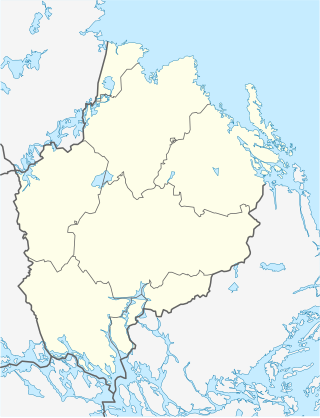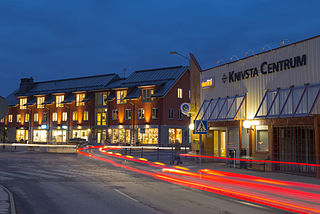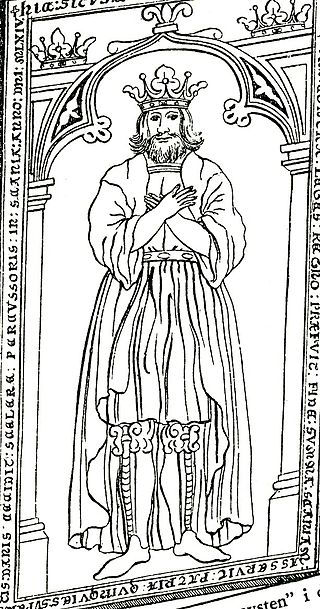
Roslagen is the name of the coastal areas of Uppland province in Sweden, which also constitutes the northern part of the Stockholm archipelago.

Gustav I, commonly known as Gustav Vasa, was King of Sweden from 1523 until his death in 1560, previously self-recognised Protector of the Realm (Riksföreståndare) from 1521, during the ongoing Swedish War of Liberation against King Christian II of Denmark, Norway and Sweden. Gustav rose to lead the Swedish War of Liberation following the Stockholm Bloodbath, where his father was executed. Gustav's election as king on 6 June 1523 and his triumphant entry into Stockholm eleven days later marked Sweden's final secession from the Kalmar Union.

Uppsala County is a county or län on the eastern coast of Sweden, whose capital is the city of Uppsala. It borders the counties of Dalarna, Stockholm, Södermanland, Västmanland, Gävleborg, and the Baltic Sea.

The Swedes were a North Germanic tribe who inhabited Svealand in central Sweden and one of the progenitor groups of modern Swedes, along with Geats and Gutes. They had their tribal centre in Gamla Uppsala.

Uppland is a historical province or landskap on the eastern coast of Sweden, just north of Stockholm, the capital. It borders Södermanland, Västmanland and Gästrikland. It is also bounded by lake Mälaren and the Baltic Sea. On the small uninhabited island of Märket in the Baltic, Uppland has a very short and unusually shaped land border with Åland, an autonomous province of Finland.
The Götaland theory is a view which challenges established history and archaeology, and claims that the foundation of Sweden occurred not in Eastern Sweden, but in the province of Westrogothia (Västergötland). The adherents of this idea use wide-ranging methods, from controversial ones, such as dowsing and asking mediums to contact the dead, to more conventional methods such as etymology, but also claim that the established academic material consists of lies and forgeries. Although well known in Sweden and fervently preached by its adherents, it has never been accepted by scholars.

Olof Skötkonung, sometimes stylized as Olaf the Swede, was King of Sweden, son of Eric the Victorious and, according to Icelandic sources, Sigrid the Haughty. He succeeded his father in c. 995. He stands at the threshold of recorded history, since he is the first Swedish ruler about whom there is substantial knowledge. He is regarded as the first king known to have ruled both the Swedes and the Geats, and the first king in Sweden to have minted coins. In Sweden, the reign of Olof Skötkonung is considered to mark the transition from the Viking Age to the Middle Ages. He was the first Christian king in central Sweden. Norse beliefs persisted in parts of Sweden until the 12–13th century, with some keeping the tradition into modern times.

Knivsta Municipality is a municipality in Uppsala County in east central Sweden. Its seat is located in the town of Knivsta, with some 7,100 inhabitants. It is known for being one of the safest municipalities in Sweden, consistently ranking among the top 5 safest for more than a decade.

Ingjald illråde or Ingjaldr hinn illráði was a semi-legendary Swedish king of the House of Ynglings, son and successor of King Anund, and the father and predecessor of King Olof Trätälja. As with many of the 5th-7th century Yngling Kings of Sweden, his historicity is contested.

Saint Erik, also called Erik Jedvardsson, Eric IX, Eric the Holy, Saint Eric, and Eric the Lawgiver, was King of Sweden from c. 1156 until his death in 1160. The Roman Martyrology of the Catholic Church names him as a saint memorialized on 18 May. He was the founder of the House of Erik, which ruled Sweden with interruptions from c. 1156 to 1250.
Emund the Old was King of Sweden from c. 1050 to c. 1060. His short reign was characterised by disputes with the Archbishopric of Bremen over church policies, and a historically debated delimitation of the Swedish-Danish border.

Inge the Elder was a king of Sweden. In English literature he has also been called Ingold. While scant sources do not allow a full picture of his term of kingship, he is known to have led a turbulent but at length successful reign of more than two decades. He stands out as a devout Christian who founded the first abbey in Sweden and acted harshly against pagan practices. The kingdom was still an unstable realm based on alliances of noblemen, and Inge's main power base was in Västergötland and Östergötland; one of the earliest chronicles that mention his reign knows him as rex gautorum, king of the Geats.
Magnus the Strong, also known as Magnus Nilsson, was a Danish duke who ruled Götaland in southern Sweden from the 1120s to c. 1132. It is disputed whether he was elected king by the Swedes, but he is nevertheless sometimes found in the modern list of Swedish monarchs as Magnus I. Snorri Sturlason gives him the epithet "Strong".

Fjärdhundraland or the land of the four hundreds is, since 1296, a part of the province of Uppland in Sweden. Its name refers to its role of providing 400 men and 16 ships for the leidang of the Swedish king at Uppsala.

Attundaland was the name given to the southeastern part of the present day province of Uppland, north of Stockholm. Its name refers to its role of providing 800 men and 32 ships for the leidang of the Swedish kings at Uppsala.

Tiundaland is a historic region, Folkland, and since 1296 part of the modern province of Uppland. It originally meant the land of the ten hundreds and referred to its duty of providing 1000 men and 40 ships for the Swedish king's leidang.

Torgny the Lawspeaker is the name of one of at least three generations of lawspeakers by the name Þorgnýr, who appear in the Heimskringla by the Icelandic scholar and chieftain Snorri Sturluson, and in the less known Styrbjarnar þáttr Svíakappa and Hróa þáttr heimska. They were the lawspeakers of Tiundaland, and all lawspeakers in the Swedish kingdom were their subordinates.
The Thing of all Swedes was the governing assembly held from pre-historic times to the Middle Ages at Gamla Uppsala, Sweden, occurring at the end of February or early March in conjunction with a great fair and a religious celebration called Dísablót. The Law of Uppland informs that it was at this assembly that the king proclaimed that the leidang would be summoned for warfare during the summer, and all the crews, rowers, commanders and ships were decided.

The Battle of Sparrsätra was fought in 1247 between the forces of King Eric XI of Sweden and rebels led by Holmger Knutsson near Enköping in Sweden. It occurred during a poorly documented period in Swedish history; as a result, many details are uncertain and conjectural.
The Law of Uppland was the law that applied in Uppland, Sweden, from 1296 to the beginning of the 1350s.
















